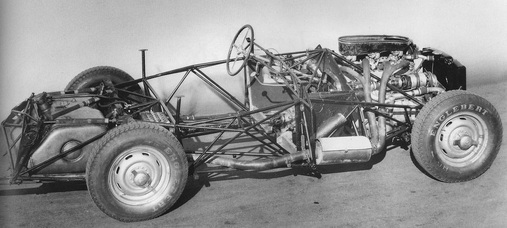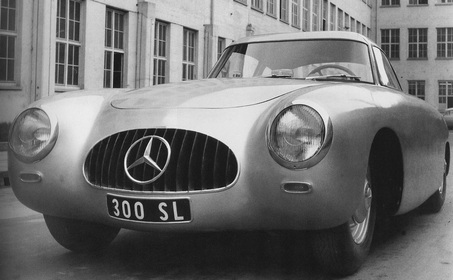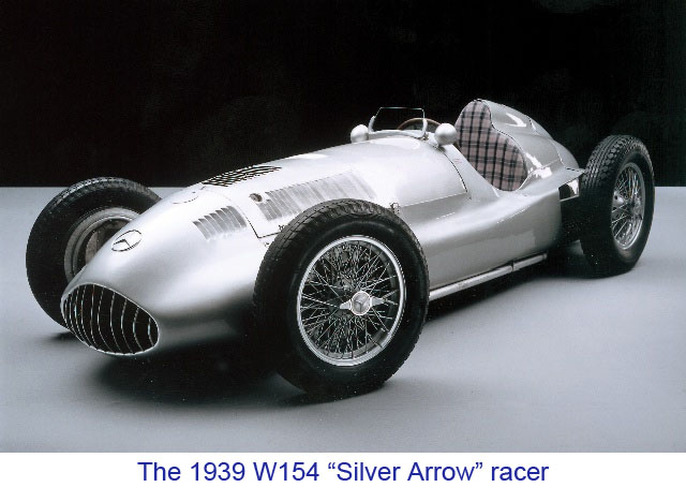Mark Passarelli on (and in) the W194
An Automotive Legend is Born

Daimler Benz had lost a lot during World War Two. In the 1930’s their “Silver Arrow” W154 racer with its supercharged V12 had been deemed the penultimate Grand Prix car, even though it raced only once and came in second. After the war, and some time to rebuild the company infrastructure, a racing program was developed with the goal to resurrect the brand’s racing prominence and recognition.
The Mercedes bodywork team had been tinkering with a lightweight aluminum shell and designed a body with amazingly low drag. This was groundbreaking technology, especially given that it was incorporated with other innovations such as integrated headlights. However, the greatest innovation was the tubular frame designed by Rudolf Uhlenhaut. Inspiration for this lightweight frame came from fighter plane technology developed during the war. As the teams at Daimler and Mercedes worked on their new racer, some compromises became necessary.
The Mercedes bodywork team had been tinkering with a lightweight aluminum shell and designed a body with amazingly low drag. This was groundbreaking technology, especially given that it was incorporated with other innovations such as integrated headlights. However, the greatest innovation was the tubular frame designed by Rudolf Uhlenhaut. Inspiration for this lightweight frame came from fighter plane technology developed during the war. As the teams at Daimler and Mercedes worked on their new racer, some compromises became necessary.
Testing the Design

To the engineers at Mercedes Benz, the chassis was the most important element of their new racer. Getting the W194 to win required testing of their innovations to the frame and motor assembly. In 1951, before they considered the Gullwing body style, Uhlenhaut and his team had to prove that the car was as fast and handled as well as they hoped. The rare photo above shows the W194 chassis under a temporary body. The hole in the left front next to the grill is an air intake for the tilted motor, a giveaway to the trained eye that beneath this decidedly ugly duckling of a body was a thing of real automotive beauty.
The Door Problem

In order to accommodate the new frame design, traditional
doors were out of the question. Gullwing
doors were developed so that they would not intrude on the frame. To keep the low profile and aerodynamic
qualities of the body design, as well as providing a low center of gravity, the
engine was mounted at a rather severe angle.
The engineers took the three liter straight six from the 300 series
passenger cars and modified the engine with 3 carburetors, overhead valves and
an overhead cam. Holes were drilled
everywhere to lighten the car, and a sparse interior was created.
The first race for the new 300SL – the SL standing for “Sport Light” – was the Mille Miglia, a 1,000 mile race. The car finished second. In the next race, the Bern Grand Prix, three 300SLs were entered and finished first and second. Next came Le Mans, for another first and second place finish and Nurburgring, where first, second, third and fourth were taken by 300SLs, the number one car coming in at the fourth position. Also, at Le Mans, the 300SL set a new average speed record of 155 KmPH. Overseas in Mexico, the cars finished first and second in the tortuous five-day Carrera Panamericana race. Only eleven W194 cars were ever made, and a few of them went through several iterations – Gullwing, open roadster, etc. It didn’t matter as the cars dominated the competition. Today, only eight of these remarkable cars survive. Among those lost is the first, the number one W194.
The legend may have died after the initial racing success if not for a visionary marketer in the United States, the Daimler Benz U.S. importer Max Hoffman. He convinced the German company that the U.S. market was ripe for a sports car based on the successful 300SL racers. The rest is automotive history.
The first race for the new 300SL – the SL standing for “Sport Light” – was the Mille Miglia, a 1,000 mile race. The car finished second. In the next race, the Bern Grand Prix, three 300SLs were entered and finished first and second. Next came Le Mans, for another first and second place finish and Nurburgring, where first, second, third and fourth were taken by 300SLs, the number one car coming in at the fourth position. Also, at Le Mans, the 300SL set a new average speed record of 155 KmPH. Overseas in Mexico, the cars finished first and second in the tortuous five-day Carrera Panamericana race. Only eleven W194 cars were ever made, and a few of them went through several iterations – Gullwing, open roadster, etc. It didn’t matter as the cars dominated the competition. Today, only eight of these remarkable cars survive. Among those lost is the first, the number one W194.
The legend may have died after the initial racing success if not for a visionary marketer in the United States, the Daimler Benz U.S. importer Max Hoffman. He convinced the German company that the U.S. market was ripe for a sports car based on the successful 300SL racers. The rest is automotive history.
Below is vintage video that shows the W194 Racer
Unprecedented Car, Unprecedented Victories

The list to the right is the 1952 races entered by the Mercedes Benz team and the new 300SL. Against the heavily favored and more powerful Porsches, Ferraris and other cars of the time, the revolutionary design of the 300SL proved itself beyond any doubt. After a minor fine-tuning following the Mille Miglia where the cars placed second and fourth, they swept the winners circle for the other four major races that year. Of course, success breeds imitation, and by 1953 the competition began copying the engineering pioneered by the 300SL. Unlike other racing teams that completely engineered their cars from the ground up, the 300SL was put together from off-the-shelf parts of existing Mercedes automobiles, making the extraordinary winning streak even more impressive. Passarelli Restorations at Hale Merced is reconstructing our W194 using exactly the same techniques and exactly the same original vintage parts as the engineers did in 1951.


